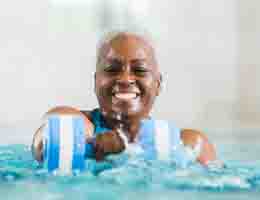Health library
Back to health libraryExercising with a hurting hip

Exercise can be a good way to manage hip pain caused by arthritis. A doctor can help you choose joint-friendly activities.
Just because you have a bad hip doesn't mean you have to give up on exercise. In fact, moving might be just what the doctor orders.
For example, if you have arthritis, regular exercise is actually a good way to manage pain. Staying active also can help you improve your mood, your sleep and your overall health.
Choose joint-friendly moves
If your hips hurt, you may need to avoid activities, like running, that put a lot of pressure on your joints. Talk about your exercise plans with your doctor or a physical therapist. They can help you choose joint-friendly exercises.
Here are some low-impact options that are easy on your hips, according to the Arthritis Foundation and other experts:
Walking. Walking can be a good choice if your hip pain isn't too bad. You can take short walks or get your steps in as part of another activity.
Working out in water. Your body is buoyant in water, which takes pressure off your hips. For a structured water workout, look for water aerobics classes at your community pool.
Riding a bike. If you can't walk well or have balance problems, a stationary bike might be a better choice than riding outdoors.
Stretching and other range-of-motion exercises. They may help keep your joints limber so you can do your daily living activities.
How to make exercise work for you
It's normal to have some joint pain and stiffness when you first start exercising. But you should start to see a decrease in pain as time goes by, the Centers for Disease Control and Prevention reports.
Here are some things that may help you manage joint pain so that you can stay active.
Start slowly. Your body needs time to adjust to new activities. Even a few minutes of exercise a day is a good start.
Change up your workout on days when you feel worse. If you have more pain or stiffness or you feel tired, try a shorter exercise session. Or switch up your exercises. For example, instead of walking, lift some hand weights. What's important is staying as active as possible safely.
Choose comfortable, well-fitting shoes. Ask your doctor if you should wear shoe inserts to help cushion your joints.
Consider hot and cold therapies. Before you exercise, take a warm shower or use an electric heating pad or a warm, wet washcloth on your hip. Heating up your joints may help loosen them up for exercise by getting the blood flowing to your muscles.
If your hip is sore right after a workout, you will probably get better relief if you apply an ice pack instead of heat, according to the Arthritis Foundation.Ask about medications. Your doctor can give you advice about using over-the-counter pain relievers.
Know when to stop. You should stop if moving your joint causes you anything more than mild pain.
See your doctor if you have:
- Sharp, stabbing or constant joint pain.
- Pain that causes you to limp.
- Pain that lasts longer than two hours after you exercise or gets worse at night.
- Pain or swelling that doesn't get better with rest, medications, or hot or cold packs.
- Joints that have a lot more swelling than usual or that feel hot or appear red.
- Any concerns about your health, your hip condition or your exercise program.
Reviewed 6/2/2025
